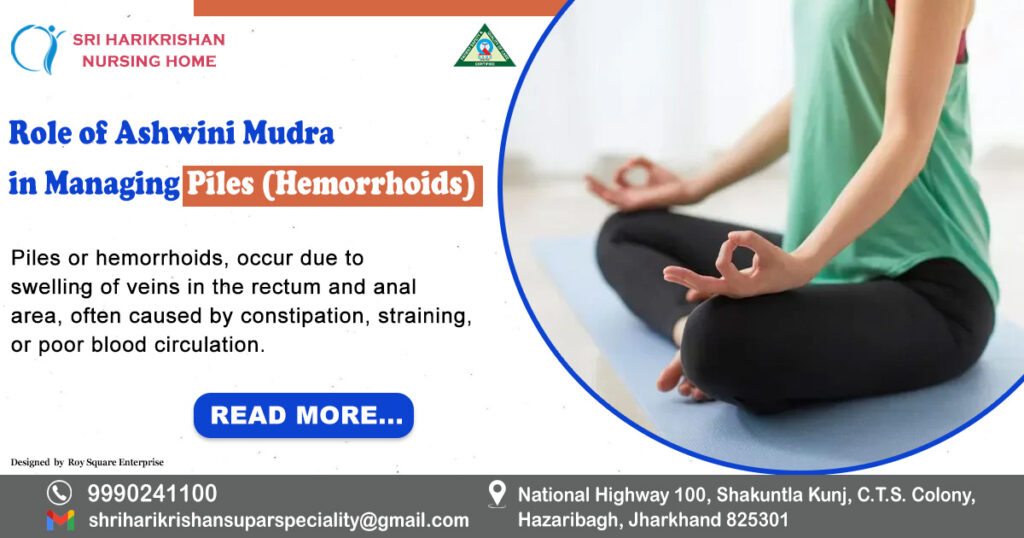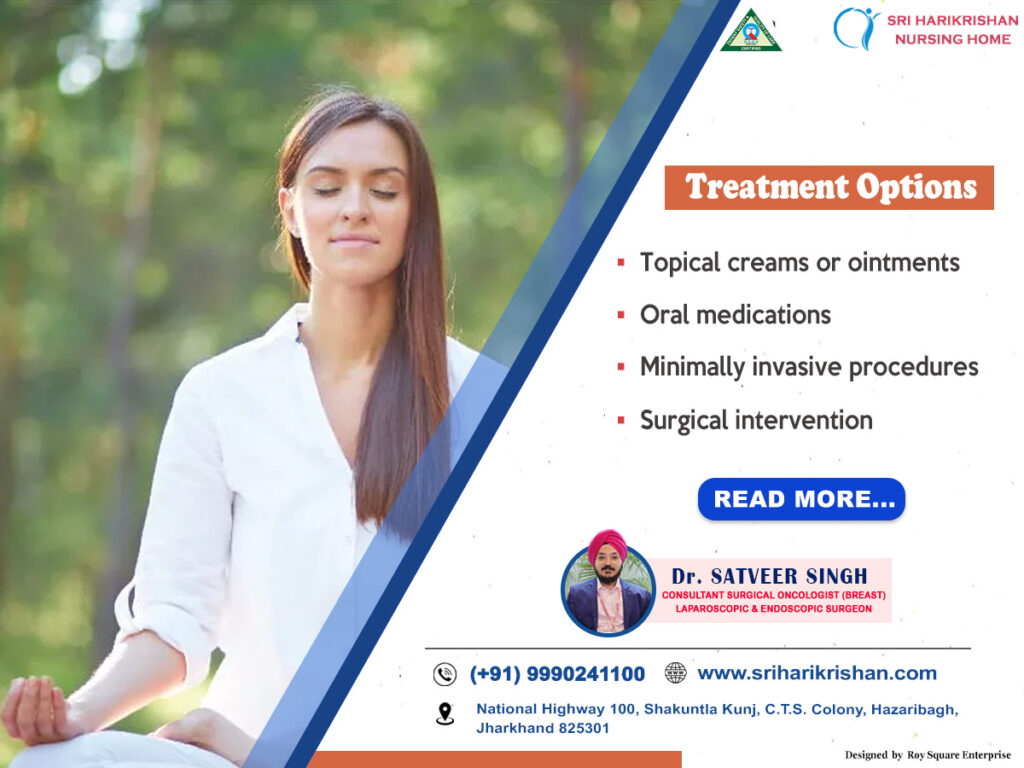Introduction
Hemorrhoids, commonly known as piles, are one of the most uncomfortable and painful conditions affecting people of all ages. While modern medicine offers many effective treatments, natural healing methods like Ashwini Mudra—a traditional yogic practice—are gaining attention for their ability to improve circulation, relieve pain, and promote long-term recovery.
In this blog, we’ll discuss in detail how Ashwini Mudra can help in the natural healing of hemorrhoids. We’ll also explore causes, symptoms, treatment options, recovery tips, and expert medical advice from Dr. Satveer Singh, Consultant Surgical Oncologist (Breast), Laparoscopic & Endoscopic Surgeon, and Back Pain Specialist—recognized as the best general surgeon in Hazaribagh, Jharkhand at Shri Harikrishan Nursing Home.

What is Ashwini Mudra?
Ashwini Mudra is a powerful yet simple yogic practice that involves the rhythmic contraction and relaxation of the anal sphincter muscles. The word “Ashwini” means horse in Sanskrit, and the mudra is named after a horse’s natural ability to contract its anal muscles repeatedly. This practice is mentioned in ancient yogic texts as a method to activate energy flow, improve digestion, and strengthen pelvic muscles.
From a medical and physiological point of view, Ashwini Mudra helps improve blood circulation in the rectal and pelvic regions, tones the anal muscles, and enhances bowel control—all of which are beneficial in managing conditions like piles (hemorrhoids), fissures, and constipation.
How to Perform Ashwini Mudra
Here’s a simple step-by-step guide to practicing Ashwini Mudra safely:
- Sit comfortably in a cross-legged position (like Sukhasana or Padma Sana).
- Inhale deeply through your nose.
- While inhaling, contract your anal muscles gently as if you are trying to stop urination or hold back stool.
- Hold this contraction for 3–5 seconds.
- Exhale slowly, relaxing the muscles.
- Repeat this process 15–20 times, twice a day.
Beginners can start with fewer repetitions and gradually increase as comfort improves.

Role of Ashwini Mudra in Managing Piles (Hemorrhoids)
Piles, or hemorrhoids, occur due to swelling of veins in the rectum and anal area, often caused by constipation, straining, or poor blood circulation. Ashwini Mudra plays a key role in managing and preventing this condition naturally by improving local circulation and muscle tone.
Here’s how it helps:
1. Improves Blood Flow
One of the main causes of piles is poor venous return (blood pooling) in the rectal area. Ashwini Mudra stimulates and improves blood circulation, preventing the veins from becoming engorged or inflamed.
2. Strengthens Anal Muscles
Repeated contraction and relaxation of the anal muscles help strengthen the sphincter muscles, making bowel movements smoother and reducing strain during defecation.
3. Prevents Constipation
Ashwini Mudra activates the pelvic floor and lower abdominal muscles, stimulating bowel movement and helping relieve constipation—one of the major causes of piles.
4. Reduces Pain and Swelling
By promoting blood flow and relieving congestion, Ashwini Mudra can reduce inflammation, pain, and itching associated with hemorrhoids.
5. Promotes Natural Healing
Consistent practice helps in faster healing of damaged tissues, as better oxygen and nutrient supply reach the affected area.
6. Stress Relief
Stress can worsen digestive problems, including constipation. Ashwini Mudra also helps relax the mind, improving overall digestive health and preventing flare-ups.
Medical Insight: Expert Opinion
According to Dr. Satveer Singh, Consultant Surgical Oncologist (Breast), Laparoscopic & Endoscopic Surgeon, and Back Pain Specialist, and the best general surgeon in Hazaribagh, Jharkhand, combining traditional yogic techniques like Ashwini Mudra with modern treatments can significantly improve patient outcomes.
He explains that while Ashwini Mudra is beneficial for mild to moderate piles, patients with advanced or thrombosed hemorrhoids may require medical or laser-assisted treatment for complete relief. Practicing Ashwini Mudra regularly after recovery can help prevent recurrence and maintain healthy bowel habits.
Precautions While Practicing Ashwini Mudra
- Avoid performing it immediately after meals.
- Do not strain the anal muscles too hard—gentle contractions are enough.
- If you experience severe pain or bleeding, consult your doctor before continuing.
Causes of Hemorrhoids
Several factors contribute to the development of hemorrhoids, such as:
- Chronic constipation or diarrhea
- Low-fiber diet
- Straining during bowel movements
- Pregnancy-related pressure
- Obesity
- Prolonged sitting
- Lack of exercise
Risk Factors
You may be at higher risk of developing hemorrhoids if you:
- Are over 40 years old
- Have a family history of hemorrhoids
- Are pregnant or postpartum
- Lead a sedentary lifestyle
- Are overweight or obese
- Consume low-fiber foods regularly
Diagnosis
A proper diagnosis is essential for accurate treatment. At Shri Harikrishan Nursing Home, Hazaribagh, Dr. Satveer Singh performs a thorough evaluation that may include:
- Physical Examination: Checking the anal region for swelling or lumps.
- Digital Rectal Exam: To feel internal hemorrhoids.
- Anoscope or Proctoscopy: For a detailed internal view.
These procedures are safe and help determine the severity of the condition for the right treatment plan.

Treatment Options
There are both medical and natural ways to manage hemorrhoids.
A. Medical Treatments
- Topical creams or ointments: To reduce pain and itching.
- Oral medications: To ease inflammation and promote healing.
- Minimally invasive procedures: Laser surgery or Sclerotherapy.
- Surgical intervention: For severe or chronic cases.
Dr. Satveer Singh, known as the best general surgeon in Hazaribagh, specializes in laser and minimally invasive surgeries for piles, ensuring faster healing and minimal discomfort.
B. Natural Healing with Ashwini Mudra
Ashwini Mudra is a powerful yogic exercise that involves rhythmic contraction and relaxation of the anal muscles.
The word “Ashwini” means horse and the practice is named after the horse’s ability to contract its anal muscles at will.
How to Perform Ashwini Mudra
- Sit comfortably in a cross-legged position (Sukhasana or Padma Sana).
- Inhale deeply and gently contract the anal sphincter muscles (as if stopping urination or stool).
- Hold for 3–5 seconds, then exhale and release.
- Repeat this cycle 20–30 times daily.
Benefits of Ashwini Mudra for Hemorrhoids
- Improves blood circulation to the rectal area.
- Strengthens anal sphincter muscles.
- Reduces swelling and inflammation.
- Prevents constipation.
- Promotes natural healing and prevents recurrence.
- Calms the nervous system and reduces stress.
When combined with a fiber-rich diet and adequate hydration, Ashwini Mudra can offer long-term relief from piles.
Recovery
Recovery depends on the severity and treatment type:
- Mild cases: Improve in a few days with natural remedies and lifestyle changes.
- Laser or surgical treatment: Recovery usually takes 2–3 days.
- With Ashwini Mudra practice: Consistent effort brings noticeable improvement within a few weeks.
Dr. Satveer Singh advises combining modern medical treatment with yogic practices like Ashwini Mudra for faster recovery and prevention.
Top 10 Frequently Asked Questions (FAQs)
1. Can Ashwini Mudra completely cure hemorrhoids?
Ashwini Mudra helps manage and prevent hemorrhoids naturally, especially in early stages. Severe cases may still require medical intervention.
2. How long should I practice Ashwini Mudra daily?
Start with 5 minutes a day and gradually increase to 15–20 minutes for best results.
3. Is Ashwini Mudra safe during pregnancy?
Yes, but pregnant women should perform it under expert supervision.
4. Can Ashwini Mudra prevent piles recurrence?
Yes, regular practice strengthens the anal muscles and improves blood flow, reducing recurrence chances.
5. Are there any side effects of Ashwini Mudra?
No side effects if done correctly. However, overexertion should be avoided.
6. What foods help prevent piles?
High-fiber foods, fruits, vegetables, and plenty of fluids help maintain regular bowel movements.
7. When should I see a doctor for hemorrhoids?
If you experience bleeding, pain, or persistent swelling, consult Dr. Satveer Singh immediately.
8. Is laser surgery safe for piles?
Yes, it’s a quick, minimally invasive, and effective treatment.
9. How soon can I resume daily activities after laser surgery?
Most patients recover within 2–3 days with minimal discomfort.
10. Who is the best doctor for hemorrhoids treatment in Hazaribagh?
Dr. Satveer Singh, Consultant Surgical Oncologist (Breast), Laparoscopic & Endoscopic Surgeon, is widely regarded as the best general surgeon in Hazaribagh, Jharkhand, for advanced hemorrhoids treatment.
Why Choose Shri Harikrishan Nursing Home, Hazaribagh?
- Expert Care: Led by Dr. Satveer Singh, a skilled and compassionate surgeon specializing in laser and minimally invasive surgeries.
- Modern Facilities: Equipped with advanced diagnostic and surgical technology.
- Patient-Centric Approach: Personalized care plans for every patient.
- Natural & Modern Integration: Offers both traditional and modern healing approaches for faster recovery.
- Quick Recovery: Focus on painless procedures and minimal downtime.
At Shri Harikrishan Nursing Home, the combination of expert medical care and natural healing ensures holistic wellness.
Conclusion
Healing hemorrhoids doesn’t always have to mean surgery or medication. With the right balance of natural techniques like Ashwini Mudra, dietary improvements, and professional medical guidance, it’s possible to experience lasting relief.
For expert care and modern treatment, visit Dr. Satveer Singh, Consultant Surgical Oncologist (Breast), Laparoscopic & Endoscopic Surgeon, and Back Pain Specialist, at Shri Harikrishan Nursing Home, Hazaribagh. With years of experience and a patient-first approach, he offers comprehensive solutions for hemorrhoids and other rectal disorders.
